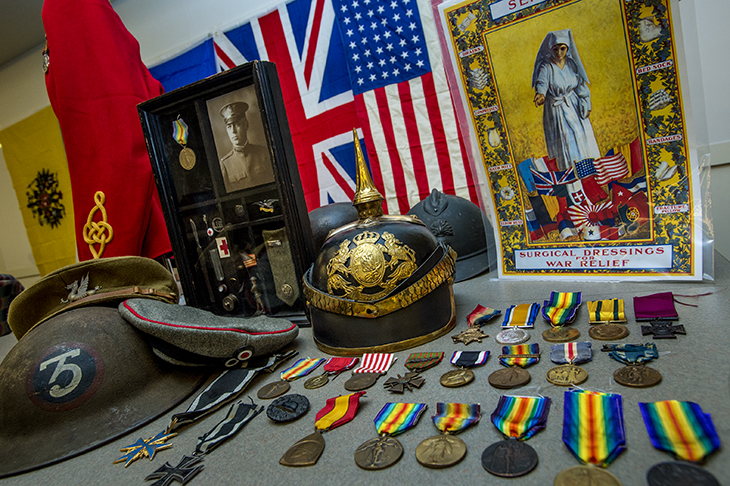Wartime medicine: The heritage of WWI

Dr. Elma LeDoux, an associate professor of medicine, uses her collection of memorabilia from “the Great War” for a hands-on seminar to teach medical students about advances in medicine. (Photo by Paula Burch-Celentano)
Vintage military uniforms, flags, a gas mask, medals, photos of soldiers in trenches and letters of encouragement and condolence are just part of the collection of World War I memorabilia amassed by Dr. Elma LeDoux.
LeDoux, faculty adviser of Tulane University School of Medicine"s History of Medicine Society, offers an exhibit of items from her personal collection together with a presentation on advances in medicine during “the Great War” as a hands-on, interdisciplinary seminar for Tulane medical students.
“I want this exhibit and my narrative to give these students, born generations after the war, some insight into the magnitude of this conflict.”—Dr. Elma LeDoux
Evolution in military tactics and innovations in war technology, together with conflict on a global scale, resulted in vast numbers of soldiers sent to the front lines and an unprecedented number of injuries.
Plastic surgeons were forced to develop new reconstructive strategies to address cases of disfiguring injuries due to artillery shell explosions, rifle and machine gun fire and burn wounds.
“World War I caused the death of twice as many American troops as the Vietnam War, and most of our Great War losses were ultimately due to infection,” said LeDoux, an associate professor of medicine who directs the Standardized Patient Program.
With the wholesale loss of limbs due to landmine explosions, infection or frostbite, prostheses for legs, arms and hands became more sophisticated.
“There was poor understanding of what we now call PTSD and traumatic brain injury,” LeDoux said. Many military authorities believed that the negative reaction of soldiers to combat, once called "shell shock,” was due to “low moral fibre,” and patients were routinely sent back to the front when physical wounds were healed.
“I want this exhibit and my narrative to give these students, born generations after the war, some insight into the magnitude of this conflict,” LeDoux said.
“As horrible as it was, World War I provided the opportunity for advances in surgery that otherwise could not have been ethically made,” she said. “Innovative surgical approaches to extremely severe injuries were attempted because there was no other recourse at that time.”
